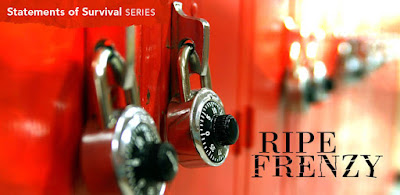As my final produced show for Boston University, I had the privilege to design for the
National New Play Network's 2016 Smith Prize for Political Theatre,
Ripe Frenzy by Jennifer Barclay. This production is a part of the rolling world premiere in collaboration with
The New Rep Theatre and Boston Center for American Performance.
In the wake of school shootings that have taken place in
the last few years, Zoe, the historian of Tavistown takes us through the
events leading up to the tragedy that occurred at Tavistown High. The story explores the issues and questions pertaining to gun violence in schools and the community that has to deal with its effects.
 |
| Photo by Kalman Zabarsky |
|
Designing costumes for a contemporary show is different from designing historical shows mainly in that most of the pieces are shopped in stores. Not a lot of pieces are built if any at all. The plus side is that clothes for a contemporary show definitely exist and can be acquired. The down side is that sometimes there are too many options and not the perfect one. Because the audience and design team is living in the same time period as the play, we all have an idea of what contemporary clothing should look like and what it conveys about each character. While this perception is true for historical period shows, it is much more subtle and real in contemporary shows. It's up to the costume designer to have a sense of this and balance out what is believable to what looks good on stage. While shopping as a job may sound easy in theory, the costume designer is not shopping purely for personal aesthetics. They have to find items that would be realistically worn by these characters and contribute to the overall stage picture.


When conceptualizing contemporary shows as with any other show, character delineation is the most important. Instead of sketching costume renderings, collages of ideas are usually fine unless there is a specific piece that will be built. Shopping requires an idea of what the characters may wear plus a sense of how they will all look together, as an individual ensemble and as ensembles in the stage picture. Fittings are very important in this process to see how these clothes fit the actors. Sometimes the perfect piece of clothing found in stores won't work for the body type, skin color etc of the actor and sometimes a "maybe" piece magically brings the entire character and stage picture together.
 |
| Photo by Kalman Zabarsky |
|
I was very fortunate that the design team for this was so open and collaborative from the get go. Communicating about set design, lights, and color palette helps us all work to complement one another's design on stage to create a cohesive overall vision. Depending on these elements, costumes can fade or get lost in the design or stand out and bring an extra visual element to characterization in addition to the work of the actors.
 |
| Photo by Kalman Zabarsky |
While the issue of gun violence may be too close for comfort at this time, the discussion and dialogue should be open and encouraged. I urge anyone who can see this play to please do so if only to begin this conversation that will hopefully develop into action.
 |
| Photo by Kalman Zabarsky |
Ripe Frenzy runs at the Studio One Theatre in Boston University College of Fine Arts (855 Commonwealth Avenue Boston, MA 02215) from February 26-March 11.












No comments:
Post a Comment